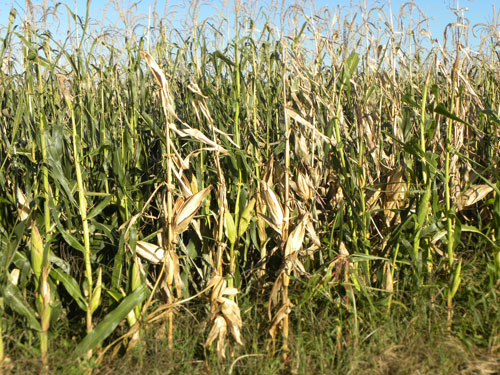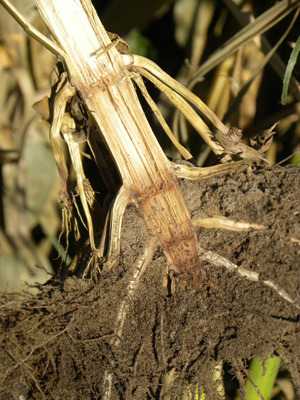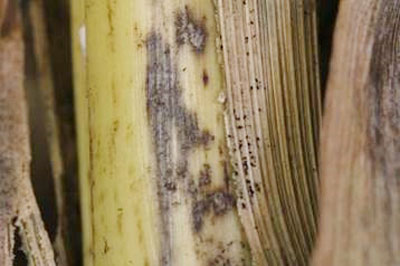Much of the 2014 Nebraska corn crop has experienced repeated and prolonged stress and wounding. While most of the corn crop looks good, we are beginning to see early evidence of problems developing. In particular, stalk rot diseases are beginning to develop in various areas across the state. Producers should strongly consider monitoring their fields for stalk rot diseases and weakened stalks as corn dries down and harvest approaches.

Weakened stalks have already become evident in some of the corn. Remember that high winds can lead to lodged corn where stalks have become weakened by stalk rot diseases and other problems. Crop stress during the 2014 growing season has and will likely contribute to the development of some stalk rot diseases. Pay special attention to fields that have one or more of these risk factors for stalk rot diseases and lodging:
- Higher yielding hybrids
- Lost leaf area (due to leaf diseases, hail, etc.)
- Excessive rainfall/ponding
- Stalk wounding, usually by hail
- High planting populations
- Thin stalks
Scouting for Stalk Rot Diseases
The first indication of a problem could be the early, and sometimes rapid, discoloration of the corn plant from green to brown or gray (Figure 1). Individual plants or patches of several plants may be affected.
Affected plants often have stalks that are hollow and easily crushed by hand or bent using the "push or pinch" test. Stalk rots can occur at any point in the stalk from the crown at/below the soil line (Figure 2) all the way to the tassel. Rotting that occurs at an upper node and kills only the upper plant parts is referred to as "top rot" and does not necessarily cause lodging of the whole plant. However, degradation of the stalk below the ear can lead to plant lodging and losses during harvest.

To scout, walk through a field and randomly select a minimum of 100 plants representing a large portion of the field. To test for stalk rot you may choose to push the plant tops away from you approximately 30° from vertical. If plants don't snap back to vertical, then the stalk has been compromised by stalk rot.
An alternative method is to use the pinch test to evaluate plants for stalk rots. Pinch or squeeze the plants at one of the lowest internodes above the brace roots. If the stalks crush easily by hand, then their integrity is reduced by stalk rot and they are prone to lodging. If more than 10% of plants in a field exhibit stalk rot symptoms, harvesting that field should be a priority over others at less risk in order to reduce the chance of plant lodging and the potential for yield loss.
Several fungi are common in our production fields and can opportunistically cause stalk rot diseases in stressed plants. Some of the most common stalk rot diseases this year are listed below.
Charcoal rot is one of the few diseases that is more common during drought conditions, so it’s more likely to affect corn in non-irrigated fields or pivot corners. The disease is characterized by the presence of many minute black round structures inside the stalk that can give it a gray to black appearance (hence the name).

n addition, the fungus that causes charcoal rot, Macrophomina phaseolina, has a wide host range and can cause the same disease in several crops, including soybean, sorghum, and alfalfa.
Fusarium stalk rot is especially common during damp conditions, but may occur anywhere, including in irrigated fields this year. The pathogen, Fusarium verticillioides, can sometimes be visible as white fungal growth on the outside of stalks at the nodes. Eventually, the disease may cause discoloration of the inside of stalks to pink or salmon.
Anthracnose stalk rot can also cause a leaf disease and is a common cause of top rots in corn. In more advanced stages the disease can cause the development of black lesions visible on the outside of the stalk and is caused by the fungus Colletotrichum graminicola.
Diplodia stalk rot can cause both an ear and stalk rot. The fungus causing Diplodia stalk rot reproduces with microscopic spores inside minute raised black structures (pycnidia) that can give the stalk a rough/sandpaper-like feeling (Figure 3).
Physoderma brown spot most commonly causes a leaf disease, but under some conditions can cause stalk rot disease. The pathogen causing Physoderma needs a lot of moisture and is more common this year due to frequent rainfall events earlier this year.
Management
There is nothing to be done at this point in the season to stop stalk rots as affected stalks will continue to degrade over time, further weakening them. But, you can work to minimize your losses by identifying which fields have the worst stalk rot diseases and adjust the harvest order of those fields. Consider harvesting or chopping those fields that are heavily impacted by stalk rots first or earlier than non-affected fields to minimize losses.
Resources
For more information on stalk rot diseases of corn, see this week's episode of Market Journal and UNL Extension publications Corn Disease Profiles II: Stalk Rot Diseases, or the more detailed publication, Common Stalk Rot Diseases Of Corn.
Diagnosis
If you are in doubt about the identity of a disease or cause of another plant problem, you can submit a sample to the UNL Plant and Pest Diangostic Clinic (P&PDC) for diagnosis. Visit the Clinic’s website for more information about these and other plant diseases, or for submission forms and submission instructions. Also see the UNL NebGuide, Row Crops Sample Submission to the Plant and Pest Diagnostic Clinic, G2226.





